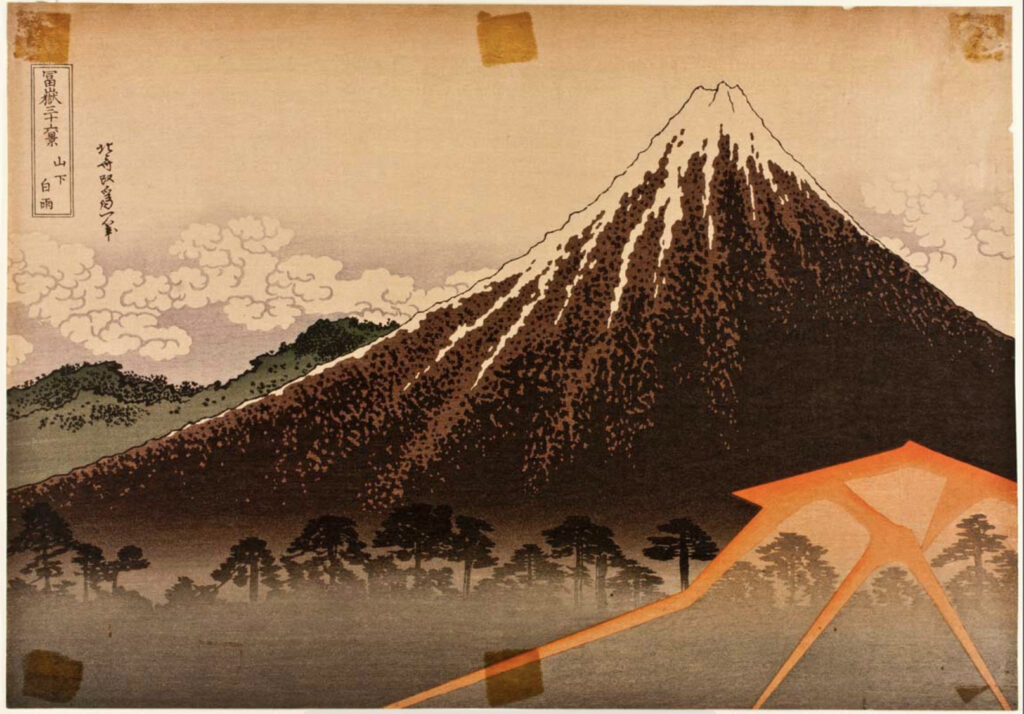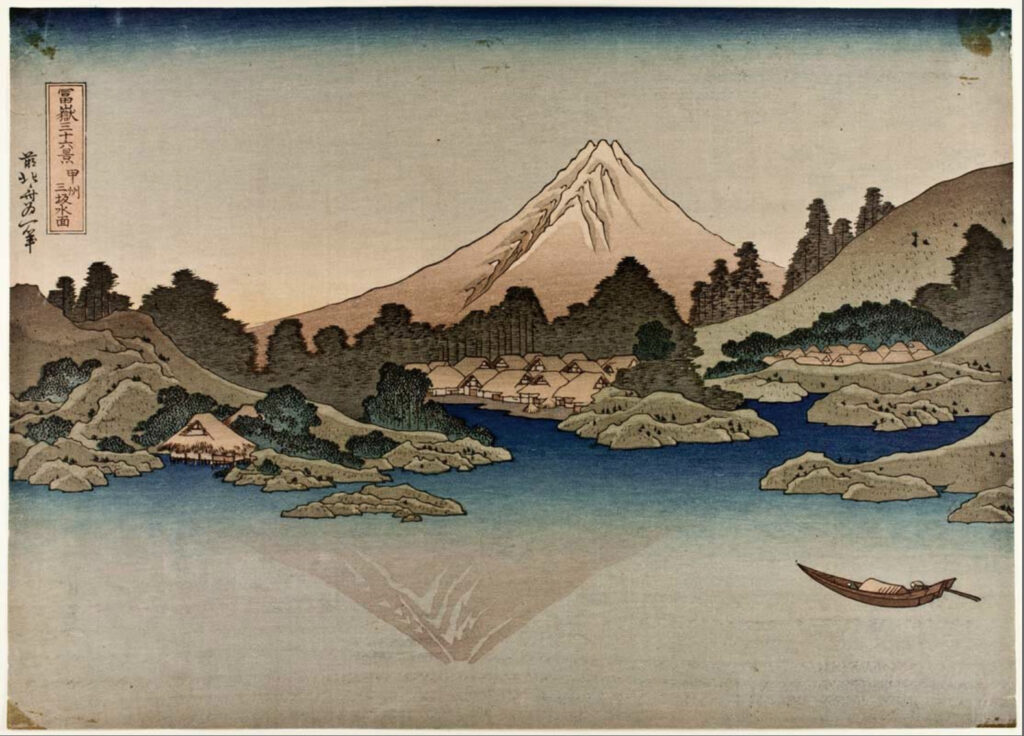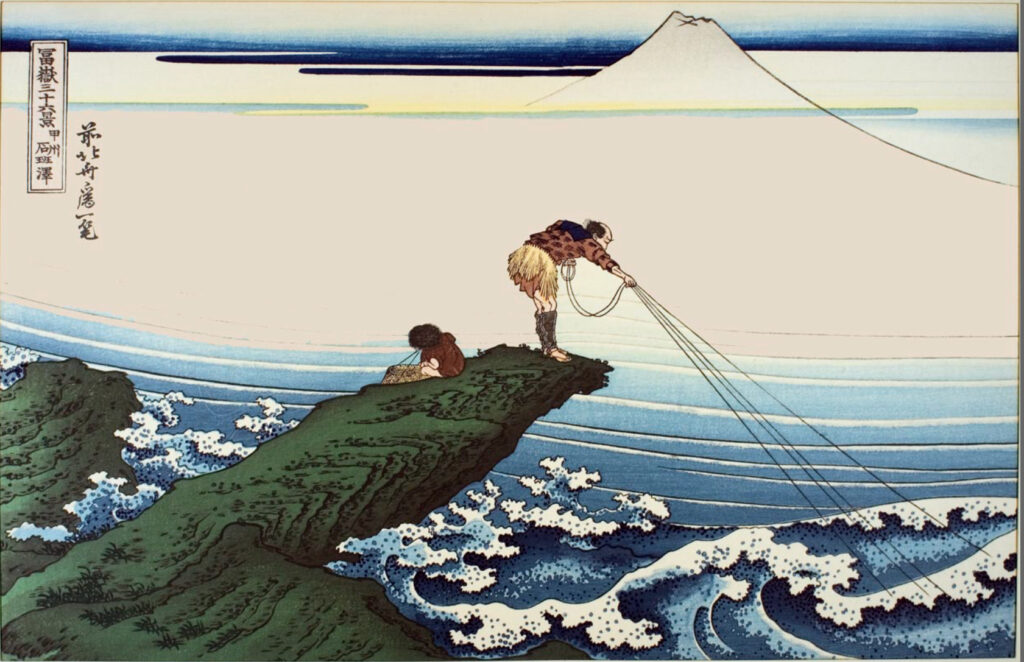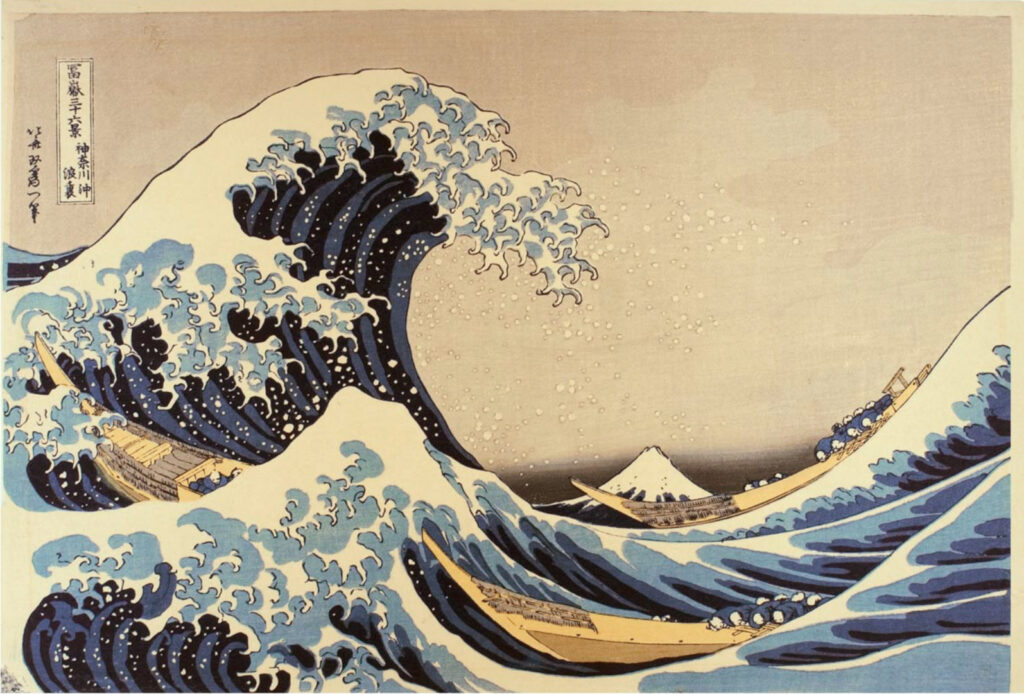
Rainstorm Beneath the Summit 
Surface of the Water at Misaka in Kai Province 
Kajikazawa in Kai Province 
The Great Wave off Kanagawa
The 18th-19th century Japanese artist, Katsushika Hokusai, created each of the prints included in this exhibition as a part of his most famous series of woodblock prints, entitled “Thirty-Six Views of Mount Fuji,” published from roughly 1826 to 1833. The exhibition aims to examine Hokusai’s use of color, composition, and historical context to draw a greater understanding of and appreciation for his distinctive choices and the story they tell. Because the series also includes some supplements, it actually consists of 46 color prints, each depicting a different scene, but all featuring Mt. Fuji. During Hokusai’s time, which occurred during Japan’s Tokugawa art period (1603–1867), the most popular and significant art style was Ukiyo-e, which means “pictures of the floating world.” Within Ukiyo-e, the concept of this series wasn’t novel, but Hokusai became known for his astonishing landscape views, highly intentional and distinguished use of color and composition, and historical scenes in which figures were often of secondary interest. And, though he produced thousands of prints, books, and traditional paintings between 1780 and 1849, this series “marked a summit in the history of the Japanese landscape print; in grandeur of concept and skill of execution there was little approaching it before and nothing to surpass it later—even in the work of Hokusai’s famed late contemporary Hiroshige (q.v.)” (Lane, 2021).
Although it is always featured, the mountain’s level of prominence in each piece varies widely across the complete “Thirty-Six Views of Mount Fuji” collection. Between the prints in this exhibition specifically, the mountain transitions from being the impressive focal point and object of strength, power, and unrelenting peace in Rainstorm Beneath the Summit and Surface of the Water at Misaka in Kai Province to representing a much more subtle –yet still constant– stillness, spirituality, and serenity of the natural world amidst the more contemporary human presence in Kajikazawa in Kai Province. Though all three maintain Hokusai’s signature use of brilliant color and composition, the positioning of the mountain changes significantly in the third piece, giving the people greater, more direct focus in this print and demonstrating the narrative of change. This evolution and contrast illustrates a parallel shift in global culture and thinking that was beginning to take hold around this time as human society grew increasingly prominent across the Earth and eventually transitioned the planet into the Anthropocene period around 1950. Similarly to Kajikazawa in Kai Province, the print that is arguably Hokusai’s most famous work, The Great Wave off Kanagawa, also depicts a shift of focus and continues the narrative. The small peak of Mt. Fuji pokes out from behind the furious waves of a vast ocean as ships of fishermen attempt to avoid catastrophe. Though a supplementary addition to the exhibition, this print illustrates a more conspicuous battle between people and the natural forces of power they must coexist with, all the while maintaining Mount Fuji’s role as a still, silent, inviolable force of nature.
As Hokusai grew as an artist, he constantly sought higher levels of creativity and skill through experimentation. Around the turn of the century, only about 20 years into his professional career, he experimented with Western-style perspective and coloring. While his style only focused in that area for a time, those techniques remained a part of his skillset and are present within work produced into his 70s. Rainstorm Beneath the Summit, Surface of the Water at Misaka in Kai Province, and Kajikazawa in Kai Province all exemplify Hokusai’s distinctive yet slightly nuanced employment of western composition and pigments, such as the brilliant and famed Prussian blue, that were not yet thoroughly adopted into the Ukiyo-e art style at the time. Prussian blue was only accidentally created in the 18th century when two German alchemists made a small error, yet it completely revolutionized the art world, which, at the time, lacked an affordable, reliable blue pigment. After exploding in popularity across Europe, Hokusai was one of the first and is still the most notable Japanese artist to bring Prussian blue to life on paper, known for combining it with indigo to create those deep gradients visible across each print in this exhibition. The Golden Ratio, also called the golden spiral, the divine proportion, or the section, is a mathematical concept rooted in ancient Greece referring to the point of natural focus within any picture or design, but also allegedly within everything else as well, including the composition of the human form. Its spiral is almost identical to that of a nautilus shell. In Hokusai’s prints, his placement of Mount Fuji falls into that central focus of the spiral with nearly perfect consistency, and even when it doesn’t occupy the primary coil, it almost always lines up with a secondary one. Because Hokusai was so known for his attention to detail, composition, and bold use of less traditional choices, his decisions throughout the series to uphold that aspect of the mountain’s arrangement within the frame, consistently deliver dazzling blue hues, and convey a narrative still relevant to our world today seem to hold even more significance.
Bibliography
“All About: Katsushika Hokusai.” All About: Katsushika Hokusai, Parkstone International, 2014, hokusai.us.com/home_en.
“How Prussian Blue Changed Everything: Christie’s.” The Transformational Powers of Prussian Blue | Christie’s, Christie’s, 14 Dec. 2017, www.christies.com/features/The-transformational-powers-of-Prussian-Blue-8758-1.aspx?sc_lang=en.
Katsushika, Hokusai. “Kajikazawa in Kai Province.” Connecticut College Asian Art Collections, Connecticut College, oak.conncoll.edu/visual/asian-art/shain-woodcuts/content/shain011_large.html.
“Katsushika Hokusai Oil Paintings: Complete Works.” Katsushika Hokusai Oil Paintings| Complete Works, 2017, www.katsushikahokusai.org/the-complete-works.html?pageno=4.
Katsushika, Hokusai. “Rainstorm Beneath the Summit.” Connecticut College Asian Art Collections, Connecticut College, oak.conncoll.edu/visual/asian-art/Caroline%20Black%20Collection%20of%20Japanese%20Woodcuts/content/_8875699201_large.html
Katsushika, Hokusai. “Surface of the Water at Misaka in Kai Province.” Connecticut College Asian Art Collections, Connecticut College, oak.conncoll.edu/visual/asian-art/Caroline%20Black%20Collection%20of%20Japanese%20Woodcuts/content/_2312112131_large.html
Katsushika, Hokusai. “The Great Wave off Kanagawa.” Connecticut College Asian Art Collections, Connecticut College, oak.conncoll.edu/visual/asian-art/shain-woodcuts/content/shain001_large.html
Lane, Richard. “Hokusai.” Encyclopædia Britannica, Encyclopædia Britannica, Inc., 6 May 2021, www.britannica.com/biography/Hokusai.